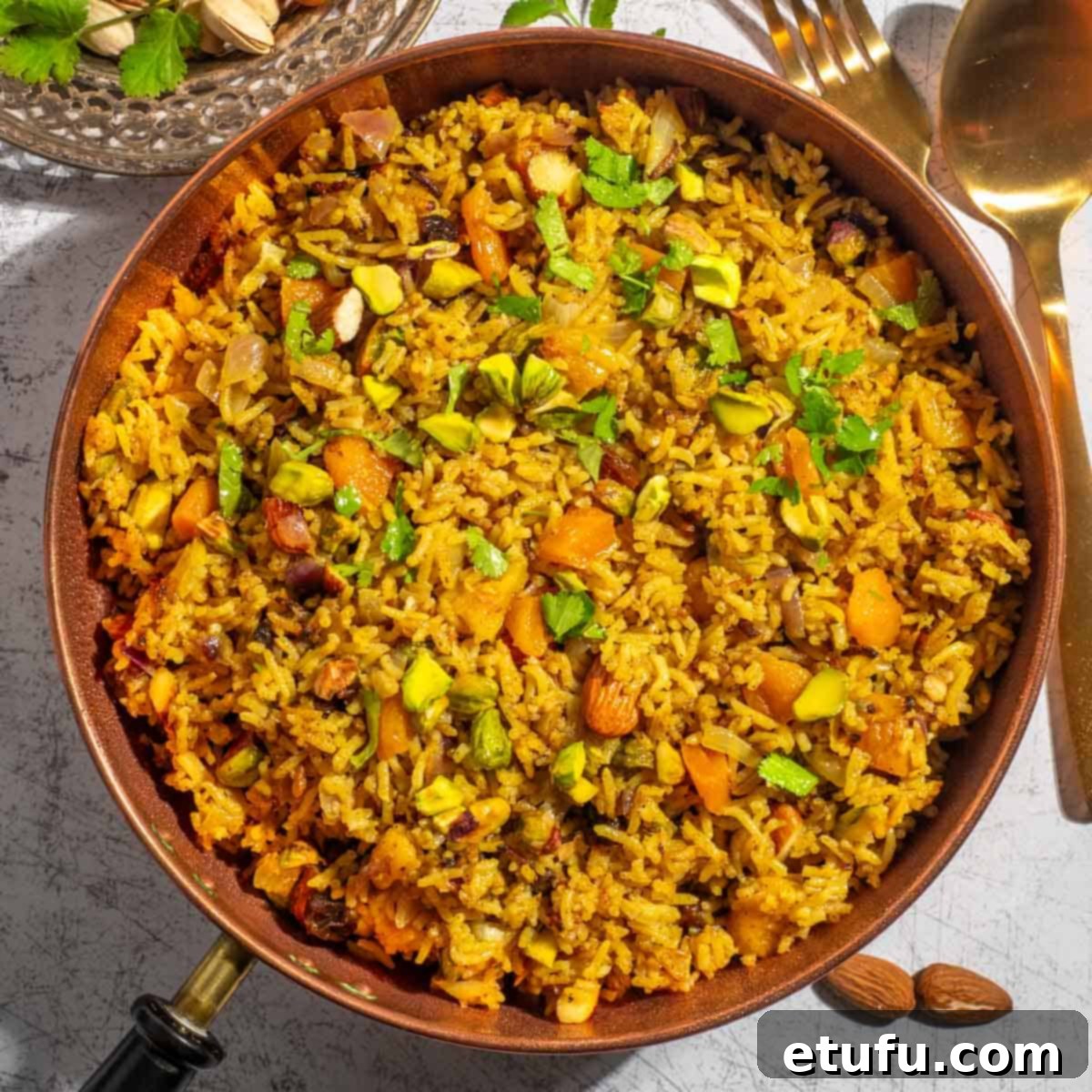Authentic Moroccan Rice Pilaf: A Fragrant Culinary Journey to North Africa
Morocco, a land of mesmerizing contrasts, invites travelers into an exotic world where vibrant souks burst with the aromas of rare spices and dazzling jewels. Ancient medinas whisper tales of history and mystery, while golden deserts stretch endlessly, carrying the echoes of age-old magic. It’s a country where every corner presents a feast for the senses, and its cuisine is no exception – a rich tapestry woven from Arab, Berber, Andalusian, and Mediterranean influences.
This exquisite Moroccan Rice Pilaf recipe aims to distill that same enchanting spirit into a single, memorable dish. More than just a simple side, it’s a celebration of North African culinary artistry, blending fluffy grains with warm, intoxicating spices, the subtle sweetness of dried fruits, and the delightful crunch of toasted nuts. Every spoonful promises a journey, transporting your palate to the bustling markets and serene landscapes of Morocco.
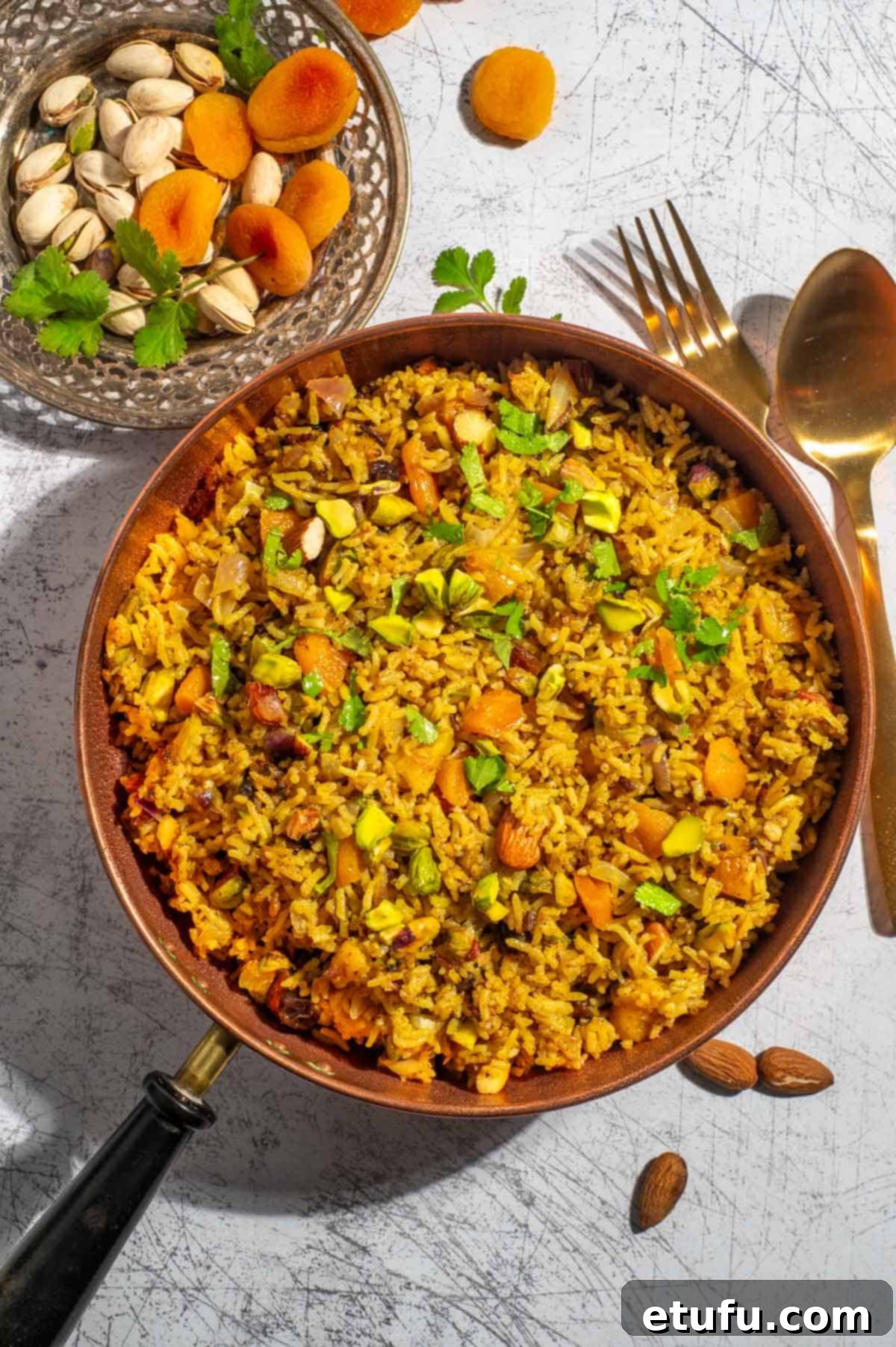
Table of Contents
- Why You’ll Adore This Moroccan Rice Pilaf
- The Essence of Moroccan Cuisine: Spices, Flavors & History
- Key Ingredients & Smart Substitutions
- Step-by-Step Instructions to Perfect Pilaf
- Expert Tips for Fluffy, Flavorful Rice
- Serving Suggestions: Perfect Pairings
- Creative Variations & Customizations
- Storage & Reheating Guidelines
- Frequently Asked Questions
- The Moroccan Rice Pilaf Recipe Card
- Nutritional Information Disclaimer
Why You’ll Adore This Moroccan Rice Pilaf
This Moroccan rice pilaf isn’t just a recipe; it’s an invitation to experience the warmth and richness of North African flavors in your own kitchen. It promises an unforgettable culinary journey, and here’s why you’ll fall in love with it:
- A Symphony of Exotic Flavors: Prepare your taste buds for an adventure! This pilaf masterfully combines bold, warming Moroccan spices like cinnamon, cardamom, and ginger with the natural, sun-kissed sweetness of dried fruits such as apricots and raisins. Add to this the satisfying crunch of toasted nuts, and you have a harmonious blend that is utterly captivating.
- Elegance in Simplicity (One-Pot Wonder!): Don’t let its sophisticated flavor profile fool you. This is a wonderfully straightforward, one-pot recipe. You’ll spend more time enjoying the aromatic process of gathering and measuring your spices than you will actually cooking. It’s designed for convenience without compromising on authentic taste.
- Incredibly Versatile Pairing: This fragrant rice pilaf is a chameleon on your dining table. It serves as an absolutely perfect accompaniment to traditional Moroccan tagines, elevates simple grilled meats (chicken, lamb, or beef) to new heights, or can even be proudly enjoyed as a hearty, satisfying vegetarian main course. It’s truly a dish that fits any occasion.
- Visually Stunning: Beyond its incredible taste, this pilaf is a feast for the eyes. The golden grains shimmer like jewels, studded with colorful dried fruits and vibrant green pistachios, making it a beautiful center piece or an impressive addition to any meal. It’s a dish as magical as the Moroccan land that inspired it.
If your culinary passion extends to creating truly spectacular rice dishes, we encourage you to explore more of our globally inspired favorites. Don’t miss the vibrant zest of this sunshine-yellow rice from South Africa, delve into the ancient charm of our easy Egyptian rice with vermicelli, or master the irresistible flavors of our popular copycat recipe for Nando’s spicy rice. Each offers a unique cultural twist to a staple grain.
The Essence of Moroccan Cuisine: Spices, Flavors & History
Moroccan cuisine stands as one of the world’s most celebrated and diverse, a testament to centuries of cultural exchange and geographical influences. Nestled at the crossroads of Africa, Europe, and the Middle East, Morocco’s culinary traditions are a vibrant mosaic, shaped by Berber, Arab, Andalusian, and even French and Spanish legacies. This rich tapestry is evident in the complex flavor profiles of its dishes, characterized by a masterful interplay of sweet and savory, hot and mild, all brought to life by an astonishing array of spices.
While tagines and couscous often take center stage, rice holds a cherished place in Moroccan culinary households, frequently appearing in aromatic pilafs like this one. These rice dishes are more than just accompaniments; they are hearty, flavorful expressions of Morocco’s spice-driven ethos.
The soul of our Moroccan Rice Pilaf lies in its carefully selected blend of spices, each contributing a unique note to the overall symphony:
- Coriander (Ground): Earthy, nutty, and with a delicate hint of citrus, it forms a robust base for the other flavors.
- Turmeric (Ground): Beyond its stunning golden hue, turmeric offers a warm, subtly bitter, and peppery flavor, providing depth and a touch of the exotic.
- Cinnamon (Ground): A hallmark of Moroccan cooking, especially in dishes that marry sweet and savory elements. It imparts a comforting, aromatic warmth.
- Cardamom (Ground): With its intensely fragrant, slightly floral, and citrusy notes, cardamom adds an intriguing brightness and a touch of luxury.
- Ginger (Ground): Contributing a fresh, pungent, and subtly spicy kick, ginger awakens the palate and adds lively warmth.
- Black Pepper: The classic, essential spice for a foundational, gentle heat that ties all the flavors together.
- Cloves (Pinch of Ground): Used sparingly, ground cloves deliver an incredibly intense, sweet, and highly aromatic depth, a signature of many North African spice blends.
Together, these spices evoke the spirit of “Ras el Hanout,” a legendary Moroccan spice mixture meaning “head of the shop” – implying the very best spices a merchant has to offer. Our blend achieves a similar, complex aromatic profile, transforming simple rice into an unforgettable, fragrant experience that speaks volumes about Morocco’s rich culinary heritage.

Key Ingredients & Smart Substitutions
Crafting the perfect Moroccan rice pilaf begins with understanding the role of each ingredient and knowing how to make smart substitutions without compromising the essence of the dish. Here, we delve deeper into the core components that bring this North African delight to life.
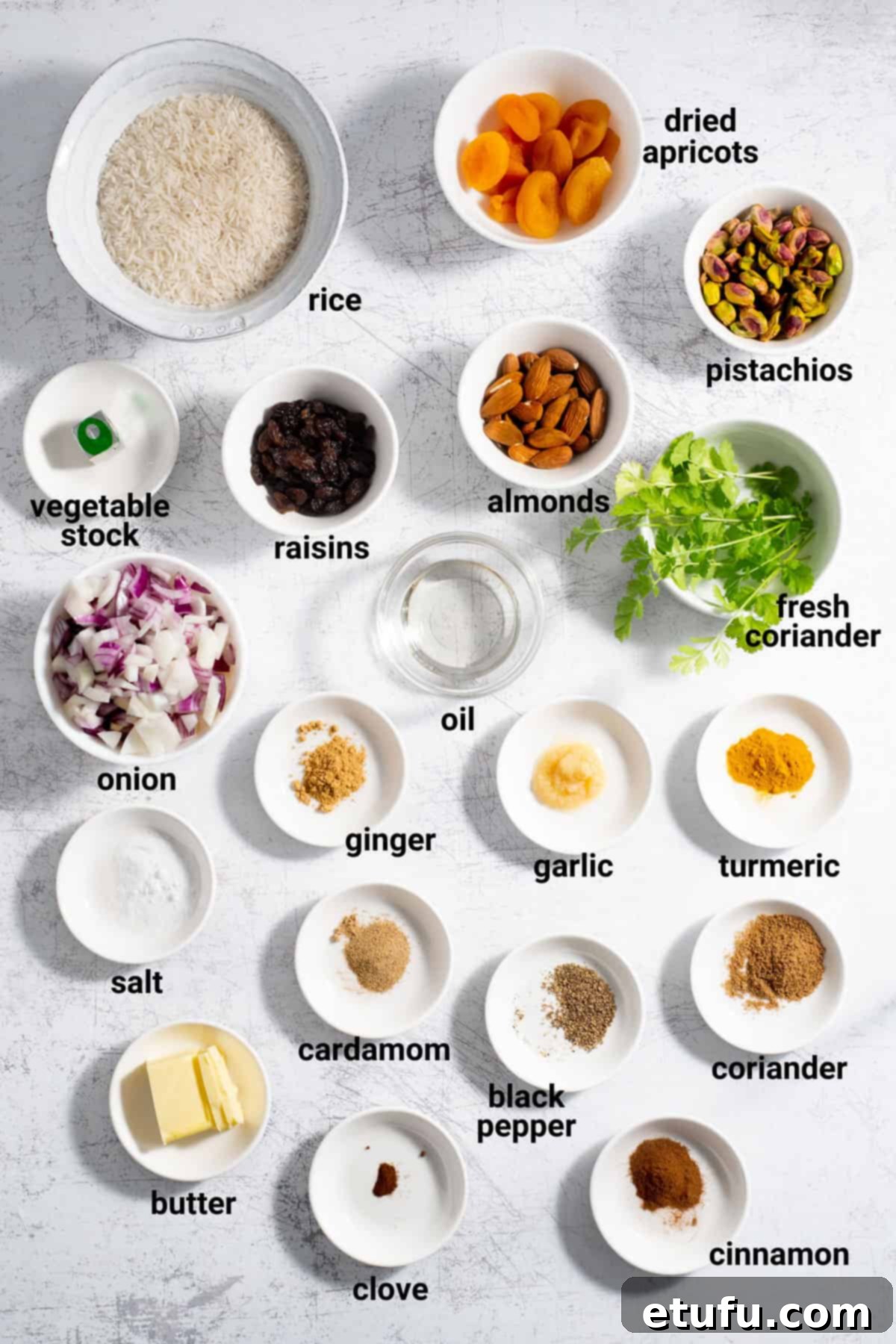
Rice: The Heart of the Pilaf
The choice of rice is paramount to achieving the desired texture in a pilaf. We wholeheartedly recommend basmati rice for this recipe. Its unique characteristics—long, slender grains, a distinctly fragrant aroma, and its ability to cook up light, separate, and fluffy—make it the ideal candidate. Basmati grains don’t clump together, allowing each individual grain to be beautifully coated in the rich, spiced flavors.
However, if basmati is unavailable, a high-quality white long-grain rice can be a suitable alternative. Look for varieties known for cooking up fluffy rather than sticky. Avoid short-grain or glutinous rice, as they will result in a completely different, undesirable texture for a pilaf.
Considering Brown Rice? For those who prefer the nutty flavor and added nutritional benefits of brown rice, it is certainly an option. However, brown rice requires a slight adjustment to the cooking method. We highly recommend soaking brown rice for at least 30 minutes, or even a few hours, before cooking. This helps to soften the outer bran, allowing for more even cooking and reducing the overall cooking time. Be prepared for the cooking duration to be slightly longer than with white rice, and adjust the liquid ratio if necessary (brown rice typically absorbs more water). You might need to add an extra ¼ to ½ cup of liquid.
Top Tip for Perfect Rice: Rinse, Rinse, Rinse!
Regardless of the type of rice you select, the single most critical step for a non-sticky, perfectly textured pilaf is thorough rinsing. Place the rice in a fine-mesh sieve and rinse it under cold running water, gently swirling with your hand, until the water running through becomes completely clear. This process effectively removes excess surface starch, which is the primary culprit behind gummy or clumpy rice.
Dried Fruits: Bursts of Sweetness and Chewiness
Dried fruits are indispensable in Moroccan pilafs, providing delightful pockets of natural sweetness and a pleasant chewiness that beautifully contrasts with the fluffy rice and crunchy nuts. For an authentic Moroccan flavor profile that balances sweetness and slight tartness, we specifically favor a combination of dried apricots and golden raisins.
However, the beauty of this dish lies in its adaptability. Feel empowered to experiment with other dried fruits that harmoniously complement the warming spices:
- Sultanas: Often smaller and sweeter than regular raisins, with a lighter color.
- Dried Cranberries: Offer a fantastic tart counterpoint and a vibrant pop of color.
- Dried Cherries: A more luxurious option, bringing deep, complex fruit notes.
- Figs: When chopped, they add a rich, jammy sweetness and a unique texture.
- Dates: Provide a luscious, caramel-like sweetness and a soft, yielding texture.
- Prunes: For a richer, more intensely fruity flavor, especially good when finely diced.
Remember to chop any larger dried fruits (like apricots, figs, dates, or prunes) into smaller, bite-sized pieces. This ensures an even distribution of their delightful flavor and texture throughout every spoonful of the pilaf.
Nuts: Essential Crunch and Richness
The inclusion of nuts is vital for introducing a crucial textural contrast and a layer of subtle richness to the Moroccan rice pilaf. Our preferred combination features pistachios, cherished for their delicate sweetness and the stunning vibrant green pops they add, alongside the classic, buttery crunch of perfectly toasted almonds.
Should you wish to explore, many other nut varieties also marry beautifully with Moroccan flavors and can be excellent substitutes or additions:
- Cashews: Offering a creamy texture and a mild, slightly sweet flavor.
- Walnuts: For a more robust, earthy flavor profile that stands up well to the spices.
- Toasted Pine Nuts: A common and highly regarded choice in Mediterranean and Middle Eastern cuisines, providing a delicate, buttery crunch when lightly toasted.
- Hazelnuts: Known for their distinct sweet, earthy, and slightly woody notes.
A crucial step for any nuts used in this pilaf is to ensure they are lightly toasted beforehand. Toasting intensifies their natural oils, significantly enhancing their flavor and making them wonderfully aromatic and crunchy. You can easily toast them in a dry pan over medium heat for a few minutes, stirring frequently until fragrant and golden, or spread them on a baking sheet and toast in a preheated oven at 180°C (350°F) for 5-7 minutes.
Step-by-Step Instructions to Perfect Pilaf
Embarking on the creation of this aromatic Moroccan rice pilaf is a simple and rewarding experience. This truly is a one-pot wonder, designed for ease and maximum flavor. Follow these detailed instructions to achieve perfectly fluffy, fragrant grains every single time.
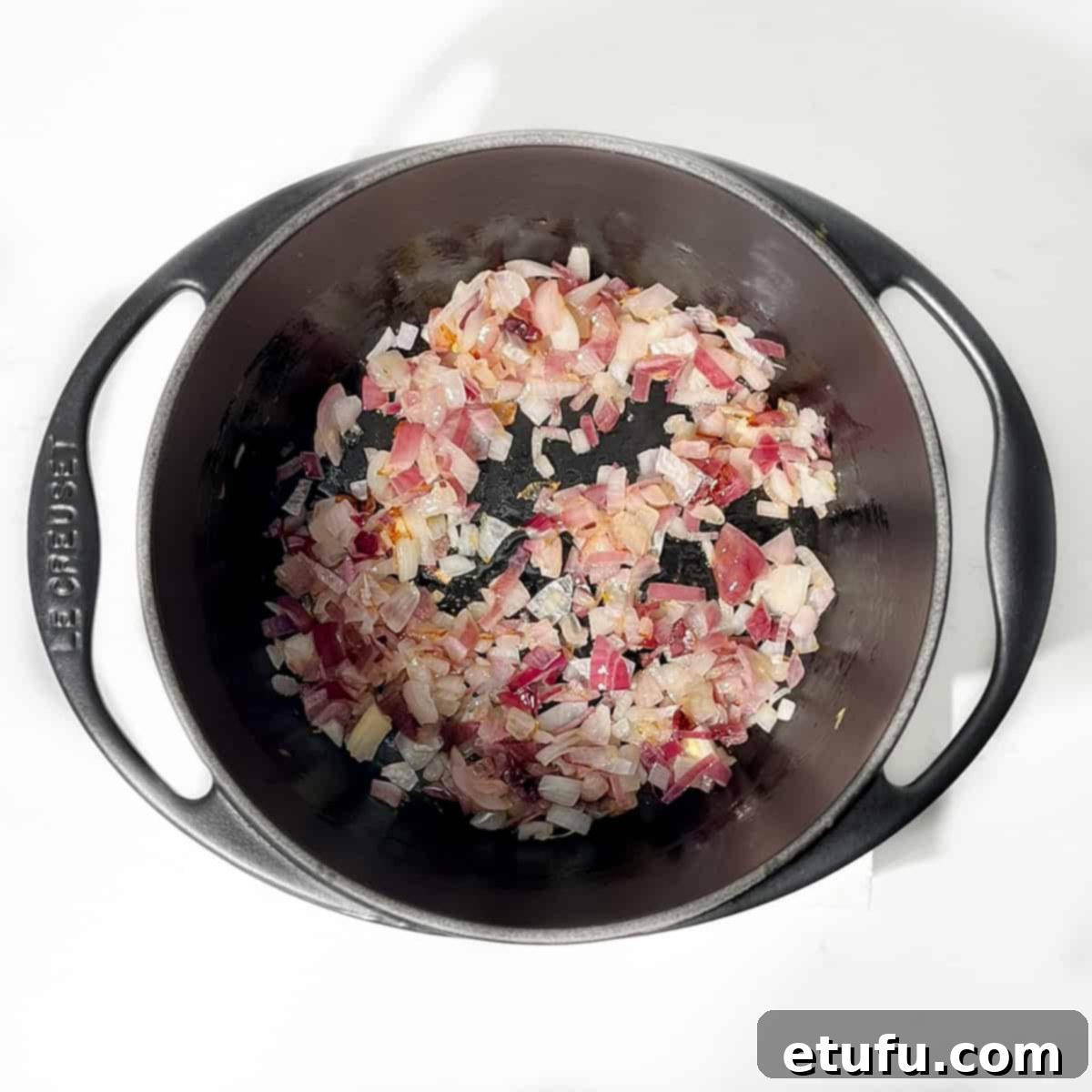
Step 1: Soften the Onions
Begin by heating the olive oil (or your preferred cooking oil) in a large, heavy-bottomed saucepan. Set the heat to medium-low. Add the finely diced onion and gently sauté for approximately 5 minutes. Your aim here is for the onions to soften and become translucent, developing a sweet base without browning. If you notice them beginning to color too much, promptly reduce the heat to prevent any bitterness.
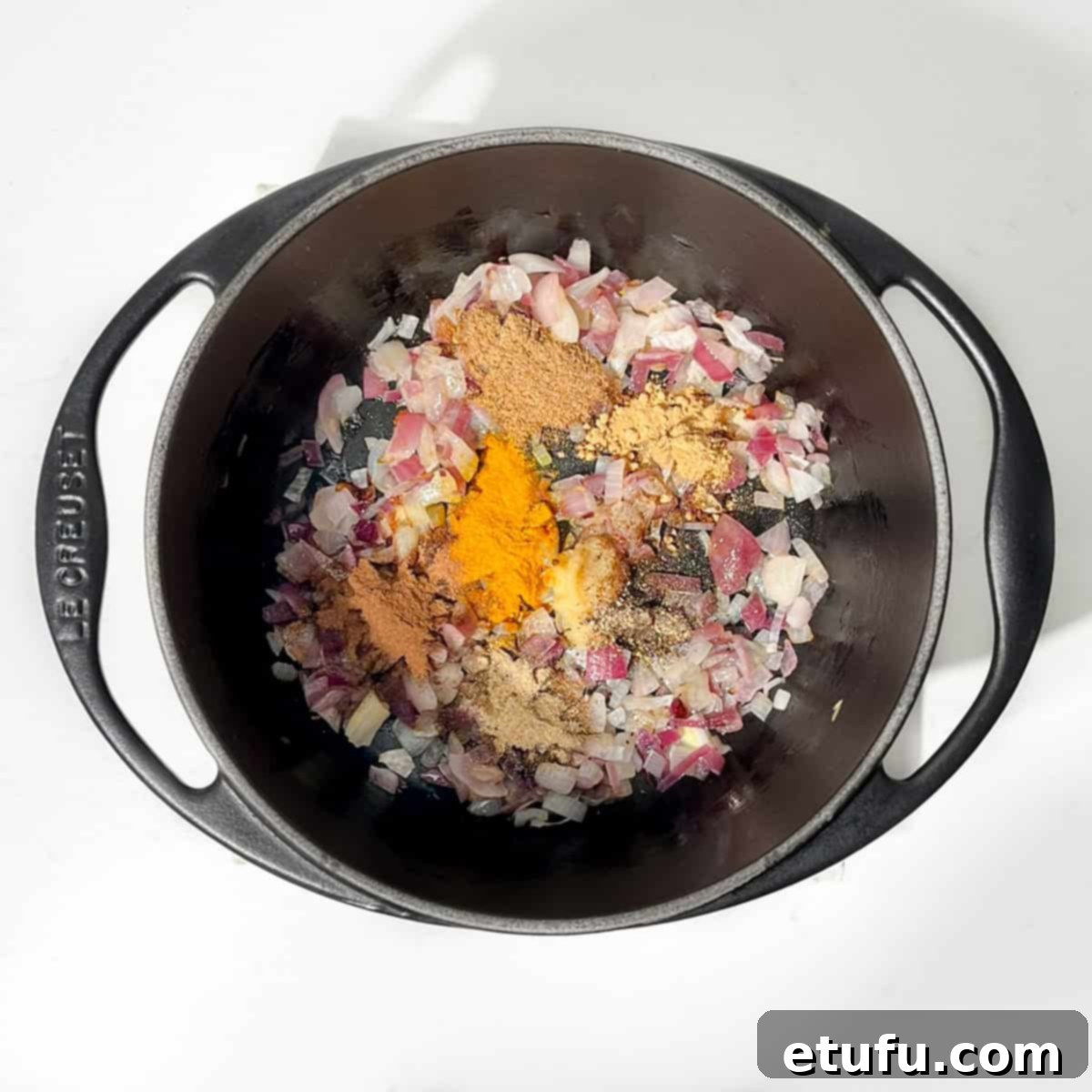
Step 2: Bloom the Spices
Once the onions are beautifully softened, introduce the minced garlic and all the fragrant ground spices: coriander, turmeric, cinnamon, cardamom, ginger, black pepper, and that crucial pinch of cloves. Stir these vigorously and constantly with the onions for 1-2 minutes. This vital step, known as “blooming” the spices, gently toasts them in the hot oil, releasing their complex essential oils and intensifying their aromas and flavors before any liquid or rice is added. Be vigilant to avoid burning the spices, which can turn them bitter.
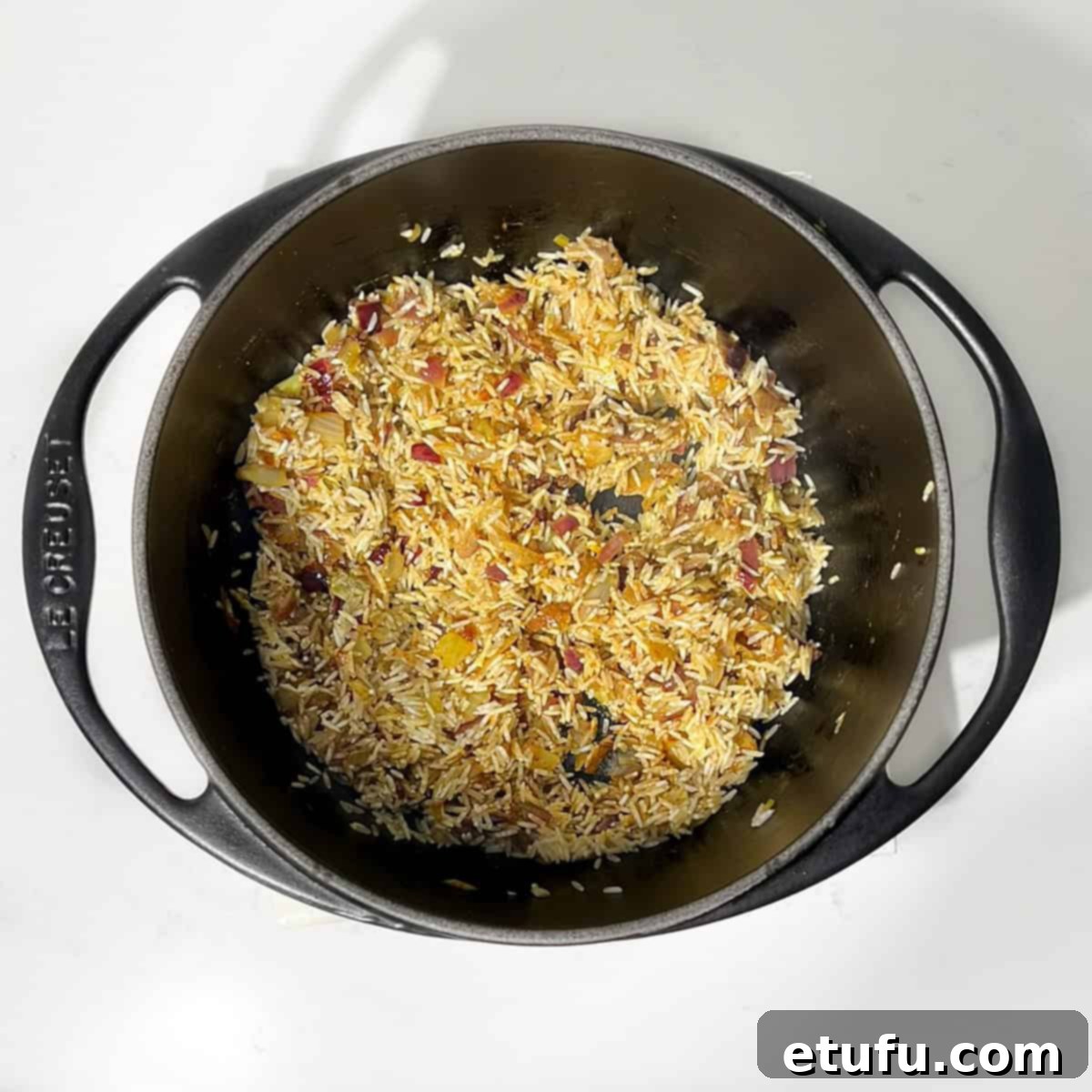
Step 3: Toast the Rice Grains
Now, add the thoroughly rinsed and drained basmati rice to the saucepan. Stir continuously for another 1-2 minutes. The objective here is to ensure that every single grain of rice is completely coated in the aromatic, oily spice mixture. This brief toasting period is key; it helps to prevent the grains from sticking together during cooking and contributes significantly to the fluffy, separate texture characteristic of a perfect pilaf.

Step 4: Simmer to Perfection
Carefully pour in the hot vegetable stock. Add the butter, salt, raisins, and the chopped dried apricots. Give everything a gentle stir to combine all the ingredients evenly. Bring the rice mixture to a gentle simmer. Once simmering, immediately cover the saucepan tightly with a well-fitting lid. It is absolutely essential that the lid creates a good seal to trap all the steam inside. If your lid isn’t perfectly snug, you can place a layer of aluminum foil directly over the pot before placing the lid on top, or even weigh the lid down with something heavy. Reduce the heat to its lowest setting and cook undisturbed for 15-18 minutes, or until all the liquid has been fully absorbed by the rice grains.
Step 5: Rest and Fluff
Once the specified cooking time has elapsed, remove the saucepan from the heat, but do not lift the lid yet. Allow the rice to rest, still covered, for an additional 10 minutes. This resting period is a non-negotiable step for achieving perfect pilaf. It allows the steam to redistribute evenly throughout the grains, ensuring they finish cooking thoroughly and become incredibly fluffy and light. After resting, carefully remove the lid and gently fluff the rice with a fork, separating the individual grains without mashing them.
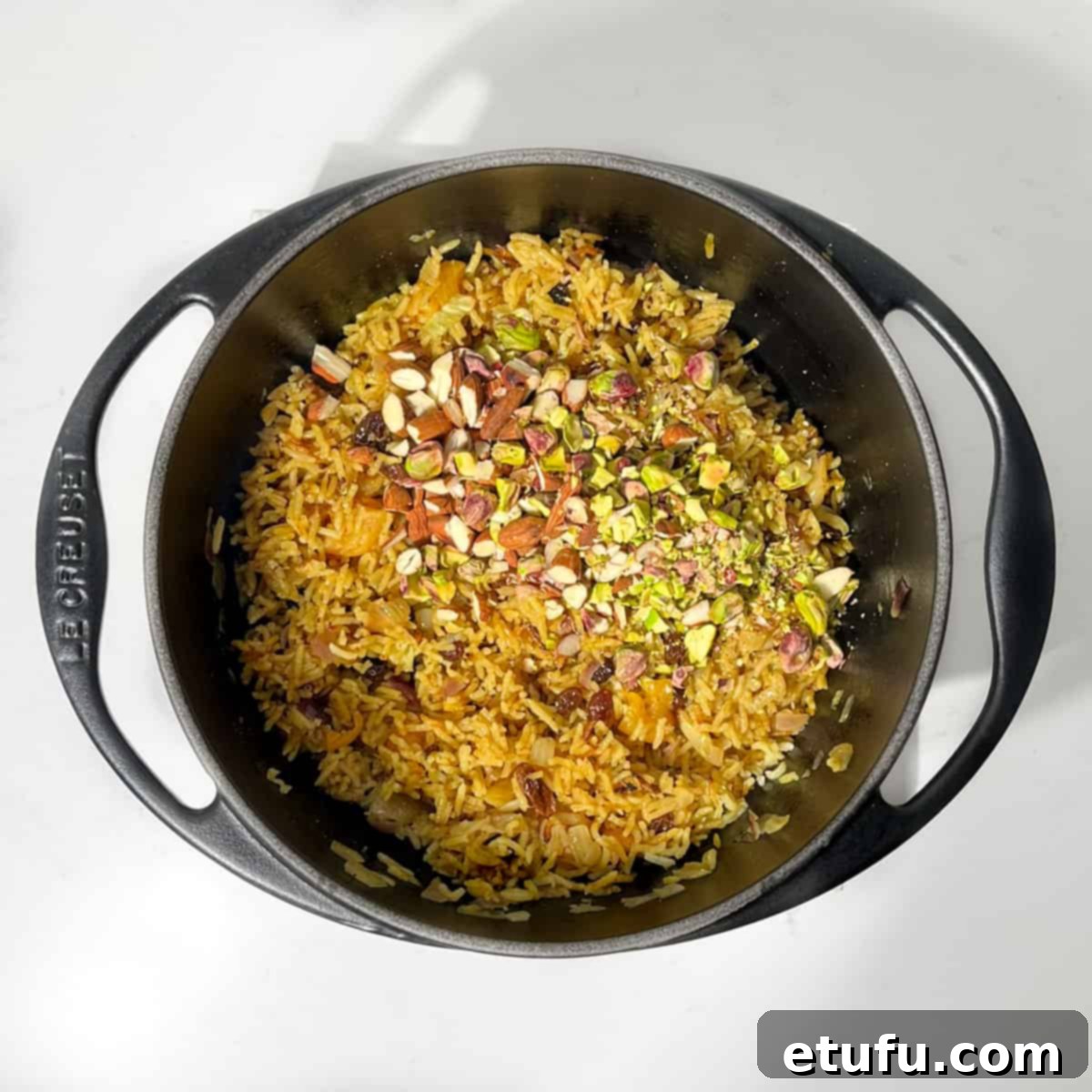
Step 6: Final Touches & Garnish
Finally, add the roughly chopped pistachios and toasted almonds to the cooked rice. Gently fold them through the pilaf, ensuring the delightful crunch is evenly distributed. Taste the rice and adjust the seasoning if necessary, adding a little more salt or pepper to your preference.
For a beautiful presentation and a burst of freshness, garnish generously with freshly chopped coriander just before serving. For an extra touch of richness and visual appeal, you can also sprinkle with additional nuts and dried fruit.
Expert Tips for Fluffy, Flavorful Rice
Transforming ordinary rice into an extraordinary Moroccan pilaf is easier than you think, especially with these insider tips:
- The Unskippable Rinse: Seriously, don’t skip rinsing the rice! This crucial step washes away excess surface starch, which is the primary cause of sticky, clumpy rice. Rinse until the water runs completely clear for consistently separate, fluffy grains.
- Bloom Your Spices: Sautéing the ground spices in hot oil for a minute or two before adding the rice is a game-changer. This “blooming” process intensifies their flavor and aroma, infusing the entire dish with deeper, richer taste. Don’t burn them, just warm them until fragrant.
- Seal the Pot Tightly: A snug-fitting lid is non-negotiable. The steam trapped inside is what gently cooks the rice evenly. If your lid has gaps, use a layer of aluminum foil underneath to create an airtight seal.
- Resist the Urge to Peek: Once the rice is covered and simmering, avoid lifting the lid at all costs. Every time you peek, precious steam escapes, leading to an unevenly cooked, potentially dry, or mushy pilaf. Trust the process and the timing.
- The Power of the Rest: The 10-minute resting period after cooking (still covered, off the heat) is just as important as the cooking itself. This allows the rice to absorb any remaining moisture and for the steam to evenly distribute, resulting in perfectly tender, distinct grains. Patience is a virtue here!
- Chop Nuts Just Right: For that delightful textural contrast, aim for a rough chop on your nuts. You want distinct pieces that provide a satisfying crunch, not fine dust that gets lost in the rice.
- Taste and Adjust Seasoning: Always perform a final taste test before serving. Flavors can mellow during cooking, and a small adjustment of salt, pepper, or even an extra pinch of a favorite spice can elevate the entire dish.
- Use Hot Stock: Adding hot or warm vegetable stock to the rice helps maintain a consistent temperature in the pot, preventing the cooking process from stalling and ensuring more even results.
Serving Suggestions: Perfect Pairings
The versatility of this fragrant Moroccan rice pilaf is one of its most appealing attributes. Its rich, aromatic, and subtly sweet flavors make it an exceptional partner to a wide variety of main courses, from traditional North African fare to simple grilled proteins. Here are some of our favorite ways to enjoy this spectacular dish:
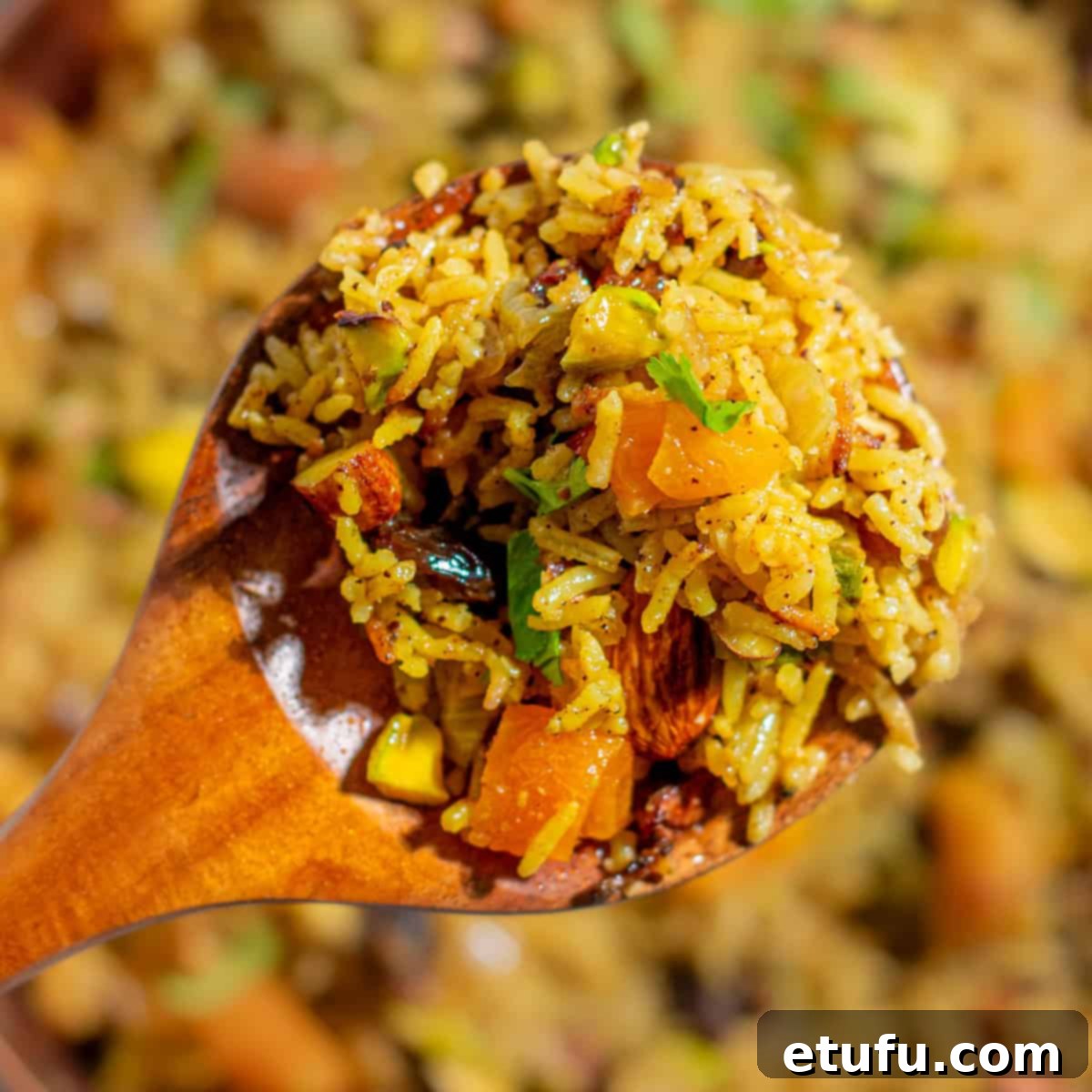
- With Classic Moroccan Tagines: This is arguably the most iconic pairing. The pilaf’s sweet and savory notes beautifully complement the slow-cooked, deeply flavored sauces of a chicken, lamb, or vegetarian tagine, soaking up every delicious drop.
- Alongside Grilled Meats: Elevate simple grilled chicken breasts, succulent lamb chops, flavorful beef kebabs, or even spiced kofta. The aromatic spices in the rice provide a wonderful counterpoint to the smoky char of grilled proteins.
- Paired with Roasted or Pan-Seared Fish: For a lighter yet equally satisfying meal, serve the pilaf with flaky grilled salmon, pan-seared spiced white fish (like cod or halibut), or delicate roasted sea bass. The rice adds depth without overwhelming the fish’s natural flavors.
- As a Base for Hearty Roasted Vegetables: Create a delightful vegetarian feast by serving the pilaf alongside a medley of oven-roasted vegetables such as carrots, butternut squash, bell peppers, zucchini, or cauliflower florets. A drizzle of good olive oil and a sprinkle of fresh herbs will complete this wholesome dish.
- Alongside Freshness: To cut through the richness and add a refreshing element, offer a dollop of cool, plain Greek yogurt or a tangy cucumber and mint salad on the side. The cool and creamy textures provide a wonderful balance.
- A Standalone Vegetarian Main: So flavorful and satisfying is this pilaf that it can easily be the star of the show. Serve a generous portion as a hearty vegetarian main course, perhaps with a side of warm pita bread or a simple green salad for a complete meal.
Creative Variations & Customizations
While our Moroccan Rice Pilaf recipe offers an authentic and delicious foundation, one of the joys of cooking is the freedom to personalize and experiment. Don’t hesitate to put your own spin on this dish with these creative variations:
- Boost with Vegetables: For added nutrients, color, and texture, consider incorporating finely diced carrots, bell peppers (red, yellow, or orange), or zucchini when you sauté the onions. Spinach or kale can also be gently wilted into the rice during its resting period.
- Add Legumes or Proteins: To make the pilaf even more substantial, stir in a can of rinsed and drained chickpeas or lentils during the last 5 minutes of cooking. Cooked, shredded chicken or lamb can also be folded in during the resting phase, warming through beautifully.
- Adjust the Spice Level: If you enjoy a little more heat, a small pinch of red pepper flakes or a dash of mild harissa paste can be added along with the other ground spices. For a milder version, you can slightly reduce the amount of ginger or black pepper.
- Brighten with Citrus: A little grated orange zest or lemon zest stirred into the finished pilaf just before serving can add a wonderful, bright, and refreshing note that beautifully complements the warm spices.
- Herbaceous Enhancements: While coriander is traditional, feel free to experiment with other fresh herbs. A mix of fresh mint and parsley, or even just fresh parsley, can add a different aromatic dimension.
- Sweetness Control: If you prefer a less sweet pilaf, simply reduce the quantity of dried fruits. Conversely, for an extra touch of sweetness, you can add a tablespoon of honey or a small amount of date syrup to the vegetable stock.
- Go Fully Vegan: This recipe is already vegetarian. To make it completely vegan, simply substitute the butter with an additional tablespoon of olive oil or use a high-quality plant-based butter alternative.
- Nut and Seed Exploration: Beyond the suggested nuts, consider toasted sesame seeds or sunflower seeds for a different texture and flavor profile.
These variations allow you to tailor the Moroccan rice pilaf to your personal taste, dietary needs, or what you have available in your pantry, making it a truly versatile and endlessly enjoyable dish.
Storage & Reheating Guidelines
While this Moroccan rice pilaf is at its absolute best when served fresh and warm, it’s completely understandable to have leftovers. Proper storage and reheating are crucial to maintain its delicious quality and, more importantly, ensure food safety.
Storage: Any leftover Moroccan rice must be cooled down rapidly. The safest practice is to transfer the rice to a clean, shallow container immediately after serving and allow it to cool quickly to room temperature (ideally within one hour). Once cooled, seal the container tightly and refrigerate it. Cooked rice can be safely stored in the refrigerator for up to 1 day. It is essential not to exceed this timeframe due to the potential for harmful bacteria to develop in cooked rice left at improper temperatures.
Reheating: When it’s time to enjoy your leftovers, always ensure the rice is reheated thoroughly until it is piping hot throughout. Never reheat rice more than once. Here are a couple of methods:
- Stovetop: Place the desired portion of rice in a saucepan. Add one to two tablespoons of water or vegetable stock per cup of rice to help rehydrate it. Cover the saucepan tightly and heat over low-medium heat, stirring occasionally, until the rice is heated through and steaming.
- Microwave: Transfer the rice to a microwave-safe dish. Add a splash of water (about one tablespoon per cup of rice) and cover the dish, leaving a small vent. Heat on high in short bursts (e.g., 1-2 minutes), stirring well between each interval, until the rice is thoroughly hot.
If you have any reheated rice that isn’t consumed, it should be discarded to ensure maximum food safety.
Frequently Asked Questions
Here are answers to some of the most common questions about preparing and enjoying this aromatic Moroccan rice pilaf:
What type of rice is truly best for making a pilaf?
For an authentic and superior pilaf, basmati rice is highly recommended. Its long, slender grains are fragrant and cook up light and fluffy, ensuring each grain remains separate. Other good quality long-grain white rice varieties can also be used, but avoid short-grain or sticky rice types as they will result in a heavy, clumpy texture.
Is rinsing the rice before cooking really necessary?
Yes, absolutely! Rinsing the rice under cold, running water until the water runs clear is a crucial step. This process removes excess surface starch, which is the primary culprit behind gummy or overly sticky rice. Skipping this step often compromises the fluffy texture that is characteristic of a good pilaf.
Can I use different types of dried fruit or nuts than those listed?
Certainly! The recipe is quite forgiving and encourages customization. While dried apricots and raisins offer a traditional Moroccan flavor, you can easily substitute them with other dried fruits like sultanas, golden raisins, dried cranberries, figs, or chopped dates. For nuts, cashews, walnuts, or toasted pine nuts are excellent alternatives to pistachios and almonds, adding their own unique crunch and flavor.
How can I make this Moroccan rice recipe vegan?
This recipe is very easy to adapt for a vegan diet. Simply replace the butter with an equal amount of olive oil or any high-quality plant-based butter alternative. All other ingredients are naturally vegan-friendly.
How do I prevent the rice from sticking to the bottom of the pot or burning?
Several factors contribute to preventing sticking: using a heavy-bottomed saucepan (like a cast iron pot) for even heat distribution, cooking over very low heat during the simmering stage, and ensuring a tight-fitting lid to properly trap steam. Additionally, making sure the rice is well-coated in oil and spices during the toasting step helps create a protective barrier around each grain.
What should I do if my rice isn’t cooked through after the recommended time?
Cooking times can sometimes vary slightly depending on your specific stove, pot, and even the type of rice. If the liquid has been fully absorbed but the rice grains are still a bit firm or chewy, add an additional 1/4 cup of hot vegetable stock or water, cover the pot tightly again, and continue to cook on the lowest heat for another 5 minutes. After this, let it rest for the full 10 minutes as directed.
Moroccan Rice Pilaf Recipe

Moroccan Rice Pilaf
Fragrant Moroccan rice pilaf with warm, aromatic spices, subtle sweetness from dried fruits, and the delightful crunch of toasted nuts. This easy one-pot recipe is perfect as a side dish for tagines or grilled meats, or enjoyed on its own as a flavorful vegetarian main. Simple to make, incredibly aromatic, and deeply satisfying!
Course:
Main Course, Side Dish
Cuisine:
Moroccan, North African
Prep Time:
10 minutes
Cook Time:
20 minutes
Resting Time:
10 minutes
Total Time:
40 minutes
Yields:
6 servings as a side
Author:
Maretha Corbett
Equipment
- 1 large lidded saucepan – A heavy-bottomed pot like cast iron works wonderfully for even heat distribution!
Ingredients
- 2 tablespoons olive oil – or other high-quality cooking oil
- 1 medium onion, finely diced
- 1 teaspoon minced garlic – or garlic paste
- 1 teaspoon ground coriander
- ½ teaspoon ground turmeric
- ½ teaspoon ground cinnamon
- ½ teaspoon ground cardamom
- ½ teaspoon ground ginger
- ½ teaspoon coarse black pepper
- Pinch of ground cloves
- 1 cup basmati rice, thoroughly rinsed and drained
- 1¾ cups (420ml) hot vegetable stock – prepared from one stock cube or homemade
- 2 tablespoons butter – 30g/1oz, or a plant-based alternative for vegan option
- 1 teaspoon salt
- 3 tablespoons raisins
- ½ cup dried apricots, chopped
- ¼ cup pistachios, roughly chopped
- ¼ cup almonds, toasted and roughly chopped
- Fresh coriander for garnish, chopped
Instructions
Heat the olive oil in a large, heavy-bottomed saucepan over medium-low heat. Add the finely diced onion and sauté for about 5 minutes until it becomes soft and translucent, ensuring not to brown it too much. Reduce heat if necessary.
Add the minced garlic, ground coriander, turmeric, cinnamon, cardamom, ginger, black pepper, and a pinch of ground cloves to the saucepan. Stir constantly for 1-2 minutes, allowing the spices to become fragrant and well-coated in the oil.
Stir in the thoroughly rinsed and drained basmati rice. Continue to stir for 1-2 minutes, ensuring all the rice grains are evenly coated with the aromatic spice and oil mixture.
Pour in the hot vegetable stock, add the butter, salt, raisins, and chopped dried apricots. Stir everything gently to combine and bring the mixture to a simmer. Cover the saucepan tightly with its lid (use foil if the lid is loose for a better seal) and reduce the heat to low. Cook undisturbed for 15-18 minutes, or until all the liquid has been absorbed.
Remove the saucepan from the heat, keeping the lid securely in place. Let the rice rest for 10 minutes. This resting period is crucial for perfect texture. After resting, remove the lid and gently fluff the rice with a fork to separate the grains.
Add the roughly chopped pistachios and toasted almonds. Gently stir them through the fluffy rice. Taste the pilaf and adjust seasoning with additional salt or pepper if desired.
Garnish generously with freshly chopped coriander before serving. For an extra touch, sprinkle with more nuts and dried fruit.
Notes
For more detailed insights and tricks to perfect your pilaf, please refer to the “Expert Tips for Fluffy, Flavorful Rice” section above.
Nutritional Data Disclaimer
Please be aware that the nutritional information provided below is an estimate, calculated by a third-party tool, and its accuracy cannot be fully guaranteed. We strive to offer the most precise information possible, but we are not responsible for any errors that may be present. The nutritional value of this recipe may also vary based on the exact brands, quantities, and specific products used. For personalized dietary advice, we strongly recommend consulting with a qualified healthcare professional or a registered dietitian.
Nutrition
Calories: 327kcal
Carbohydrates: 46g
Protein: 6g
Fat: 15g
Saturated Fat: 4g
Polyunsaturated Fat: 2g
Monounsaturated Fat: 8g
Trans Fat: 0.2g
Cholesterol: 10mg
Sodium: 720mg
Potassium: 380mg
Fiber: 4g
Sugar: 8g
Vitamin A: 710IU
Vitamin C: 3mg
Calcium: 53mg
Iron: 1mg
For important food safety advice, including comprehensive guidance on food allergies and proper handling, please consult reputable food safety resources.
